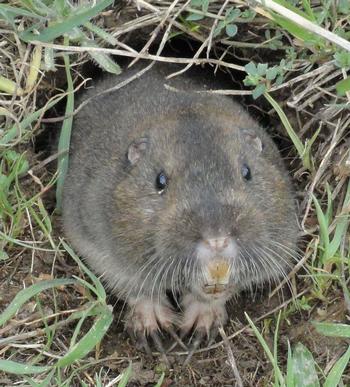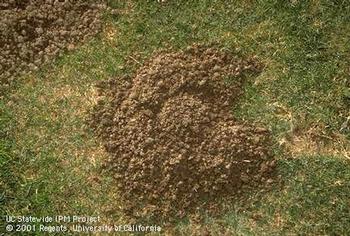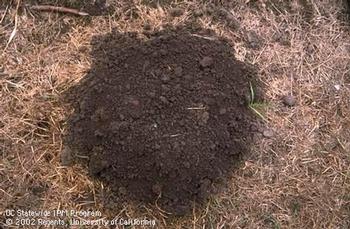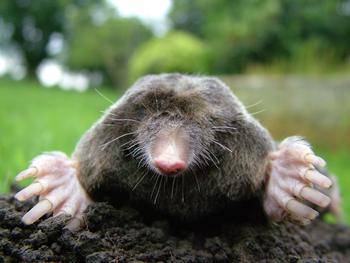Uninvited guests: managing gophers
-
Marie Narlock
-
They may be cute in children's books, but gophers are among the most exasperating garden pests. Unless you're willing to wave a white flag, it's critical to stop an invasion before it gets out of hand. Managing gophers takes persistence. But tell that to a friend whose vegetable garden has been decimated and you may not be invited back.
 Gophers close their lips behind four large incisor teeth to keep dirt out of their mouths while digging. Photo: Creative Commons
Gophers close their lips behind four large incisor teeth to keep dirt out of their mouths while digging. Photo: Creative CommonsIn a perfect world, gopher populations would be kept in check by predators: owls and hawks swooping down and snakes slithering into tunnels for dinner. While this does occur, and is certainly to be encouraged, there are always some leftovers for us humans to manage. Plus, gophers have developed defense mechanisms, such as quickly building earthen plugs to block a snake's speedy advance.
In a parallel perfect universe, home remedies would be effective: filling tunnels with chewing gum, laxatives, bleach, lye, castor oil, or human hair. Installing vibrating and high-pitched gizmos. Planting garlic or castor beans or gopher spurge. Unfortunately, these so-called repellants don't work. Neither does flooding tunnels, which wastes precious water. Besides, do you really want to put bleach in your soil?
Know your enemy.
Gophers are engineered for excavating. They have strong, clawed front paws, small eyes and ears, fur that doesn't get matted in damp tunnels, and extra sensitive whiskers for navigating in the dark. They close their lips behind four large teeth to keep dirt out of their mouths while digging. Gophers are often called pocket gophers because they have fur lining the pouches inside their cheeks. Adorable, right? Not so much if they've feasted on the roots of your prized baby fruit trees. Scientifically speaking, gophers go by the name Geomyidae bursarius.
One gopher burrow system can extend 2,000 square feet, each tunnel about the diameter of a tennis ball. Gophers are herbivores, eating plant roots, bulbs, tubers and seeds. In addition to killing or damaging plants, gophers gnaw on irrigation lines and tip over trees by destabilizing the soil around them. Gophers are mostly active in spring and fall. Gophers create crescent-shaped soil mounds and dig tunnels the diameter of a tennis ball. Photo: UC Regents
Gophers create crescent-shaped soil mounds and dig tunnels the diameter of a tennis ball. Photo: UC RegentsPrevention first.
The only way to avoid gopher damage is to kill or exclude them. Since it's always a bonus to avoid killing a living creature, prevention is key.
To exclude gophers, line the bottom of raised beds with half-inch hardware cloth ("gopher wire") and extend it halfway up the sides. For in-ground beds, lay a six to eight-inch band of gopher wire six to eight inches below the top of the bed. Use gopher baskets for new plants and trees. Bury it 18 inches deep. Leave six inches visible to discourage above-ground nibbling.
Watch for clues. Moles leave round, volcano-shaped mounds and/or surface tunnels the diameter of a golf ball. Photo: UC Regents
Moles leave round, volcano-shaped mounds and/or surface tunnels the diameter of a golf ball. Photo: UC RegentsGophers create crescent-shaped soil mounds with an entry/exit hole plugged and off to one side, as opposed to moles who leave round, volcano-shaped mounds often with central plugs and/or ridges created as the mole forces its way through the soil.
Try traps first.
Trapping is the most dependable control method. It's also more environmentally friendly than baits, which risk poisoning wildlife, kids, and pets. UC Davis researchers confirm that adding bait near traps does not increase effectiveness.
Common gopher traps include Macabee, Cinch, and Gophinator. After locating the main burrow, usually eight to twelve inches from the hole, dig a hole and set the trap. If you don't catch a gopher in two days, move the trap. Visit the UC Marin Master Gardener YouTube channel to learn how to set a trap.
What about moles? Moles live almost entirely underground and rarely eat plants, but their tunneling still causes damage. Photo: Michael David Hill
Moles live almost entirely underground and rarely eat plants, but their tunneling still causes damage. Photo: Michael David HillMoles aren't winning any beauty contests. They have poorly-developed eyes, pointy snouts, short, bare tails and spade-like limbs. They eat worms and insects and live almost entirely underground in interconnecting tunnels the diameter of golf balls. They rarely eat plants, but their burrowing can dislodge plants, dry roots, and render lawns unsightly. Moles are active all year, but they typically don’t inflict severe damage to gardens. Sometimes you can spot mole feeding tunnels up near the surface. In that case, they can be managed like gophers.




